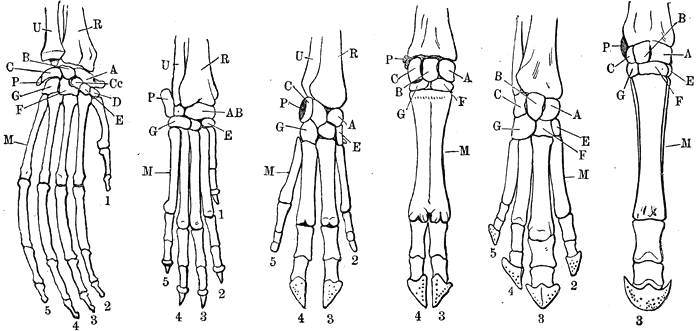|
Tarsal Formula
A tarsal formula states the number of segments of an insect's tarsi as three numbers, a-b-c, starting with the fore leg (a), then the middle leg (b), then the hind leg (c). For example, a tarsal formula of "5-5-4" as found in the Trictenotomidae means there are five segments in the fore leg's tarsi, five segments in the middle leg's tarsi, and four segments in the hind leg's tarsi. This character is especially useful at family rank and higher. References Insect anatomy {{insect-anatomy-stub ... [...More Info...] [...Related Items...] OR: [Wikipedia] [Google] [Baidu] [Amazon] |
Arthropod Leg
The arthropod leg is a form of jointed appendage of arthropods, usually used for walking. Many of the terms used for arthropod leg segments (called podomeres) are of Latin origin, and may be confused with terms for bones: ''coxa'' (meaning hip (anatomy), hip, : ''coxae''), ''trochanter'', ''femur'' (: ''femora''), ''tibia'' (: ''tibiae''), ''tarsus'' (: ''tarsi''), ''ischium'' (: ''ischia''), ''metatarsus'', ''carpus'', ''dactylus'' (meaning finger), ''patella'' (: ''patellae''). Homology (biology), Homologies of leg segments between groups are difficult to prove and are the source of much argument. Some authors posit up to eleven segments per leg for the most recent common ancestor of Neontology, extant arthropods but modern arthropods have eight or fewer. It has been argued that the ancestral leg need not have been so complex, and that other events, such as successive loss of function of a Homeobox, ''Hox''-gene, could result in Parallel evolution, parallel gains of leg segments ... [...More Info...] [...Related Items...] OR: [Wikipedia] [Google] [Baidu] [Amazon] |
Fore Leg
A forelimb or front limb is one of the paired articulated appendages (limbs) attached on the cranial (anterior) end of a terrestrial tetrapod vertebrate's torso. With reference to quadrupeds, the term foreleg or front leg is often used instead. In bipedal animals with an upright posture (e.g. humans and some other primates), the term ''upper limb'' is often used. A forelimb is not to be confused with a forearm, which is a distal portion of the human upper limb between the elbow and the wrist. All vertebrate forelimbs are homologous, meaning that they all evolved from the same structures. For example, the flipper of a turtle or of a dolphin, the arm of a human, the foreleg of a horse, and the wings of both bats and birds are ultimately homologous, despite the large differences between them. Specific uses of the forelimbs may be analogous if they evolved from different sub-structures of the forelimb, such as the flippers of turtles and dolphins, and the wings of birds and bats. ... [...More Info...] [...Related Items...] OR: [Wikipedia] [Google] [Baidu] [Amazon] |
Trictenotomidae
The Trictenotomidae are a small family of beetles in the superfamily Tenebrionoidea, containing fifteen species in two genera. Most species are found in the Oriental realm where they live in montane forest habitats. The family is considered, based on larval characters as well as sequence-based studies, to be closely related to the Salpingidae.Adult Trictenotomidae can be mistaken for Cerambycidae (Prioninae) or Lucanidae but their 5-5-4 tarsal formula makes them distinctive. They have a long 11-segmented antenna. There are no fossil species known as yet, and nearly all the species are found mainly along the Himalayas extending into China, Korea, the Sunda Islands, and the Philippine Archipelago. ''Trictenotoma grayi'' is found in the Western Ghats of peninsular India while ''T. templetonii'' is found in Sri Lanka. Adult beetles are attracted to lights and specimens are found widely in collections around the world however very little was known of their life-history until the habits ... [...More Info...] [...Related Items...] OR: [Wikipedia] [Google] [Baidu] [Amazon] |
Family (biology)
Family (, : ) is one of the eight major hierarchical taxonomic ranks in Linnaean taxonomy. It is classified between order and genus. A family may be divided into subfamilies, which are intermediate ranks between the ranks of family and genus. The official family names are Latin in origin; however, popular names are often used: for example, walnut trees and hickory trees belong to the family Juglandaceae, but that family is commonly referred to as the "walnut family". The delineation of what constitutes a family—or whether a described family should be acknowledged—is established and decided upon by active taxonomists. There are not strict regulations for outlining or acknowledging a family, yet in the realm of plants, these classifications often rely on both the vegetative and reproductive characteristics of plant species. Taxonomists frequently hold varying perspectives on these descriptions, leading to a lack of widespread consensus within the scientific community ... [...More Info...] [...Related Items...] OR: [Wikipedia] [Google] [Baidu] [Amazon] |


